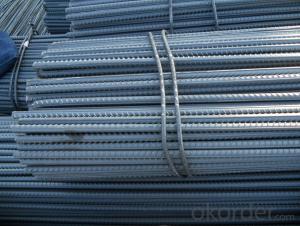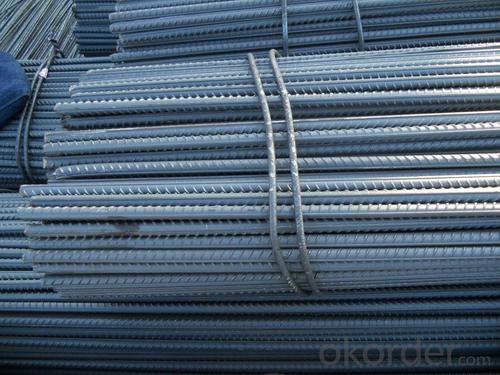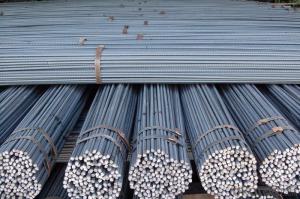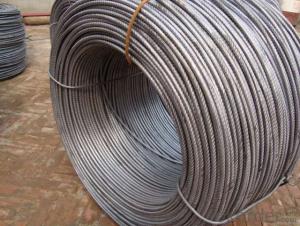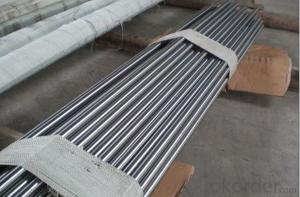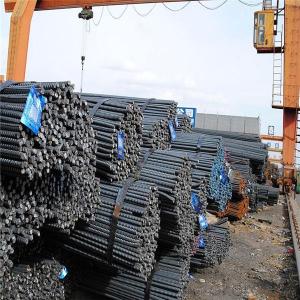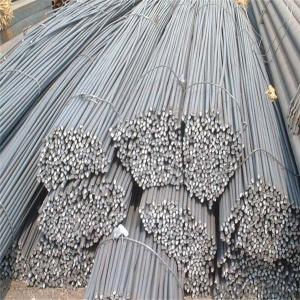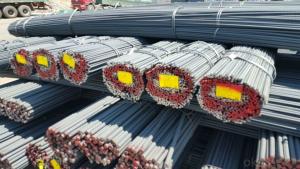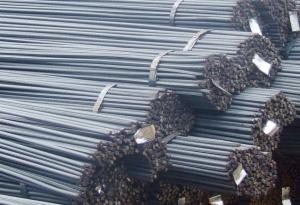High Quality GB Standard Deformed Steel Rebar HRB400
- Loading Port:
- China main port
- Payment Terms:
- TT or LC
- Min Order Qty:
- 50 m.t.
- Supply Capability:
- 100000 m.t./month
OKorder Service Pledge
OKorder Financial Service
You Might Also Like
Specifications of High Quality GB Standard Deformed Steel Rebar HRB400
Standard | GB | HRB400 | |
Diameter | 6mm,8mm,10mm,12mm,14mm,16mm,18mm,20mm, 22mm,25mm,28mm,32mm,36mm,40mm,50mm | ||
Length | 6M, 9M,12M or as required | ||
Place of origin | Hebei, China mainland | ||
Advantages | exact size, regular package, chemical and mechanical properties are stable. | ||
Type | Hot rolled deformed steel bar | ||
Brand name | DRAGON | ||
Chemical Composition of High Quality GB Standard Deformed Steel Rebar HRB400
(Please kindly find our chemistry of our material based on HRB500 as below for your information)
Grade | Technical data of the original chemical composition (%) | ||||||
C | Mn | Si | S | P | V | ||
HRB400 | ≤0.25 | ≤1.60 | ≤0.80 | ≤0.045 | ≤0.045 | 0.04-0.12 | |
Physical capability | |||||||
Yield Strength (N/cm²) | Tensile Strength (N/cm²) | Elongation (%) | |||||
≥400 | ≥570 | ≥14 | |||||
Theoretical weight and section area of each diameter as below for your information:
Diameter(mm) | Section area (mm²) | Mass(kg/m) | Weight of 12m bar(kg) |
6 | 28.27 | 0.222 | 2.664 |
8 | 50.27 | 0.395 | 4.74 |
10 | 78.54 | 0.617 | 7.404 |
12 | 113.1 | 0.888 | 10.656 |
14 | 153.9 | 1.21 | 14.52 |
16 | 201.1 | 1.58 | 18.96 |
18 | 254.5 | 2.00 | 24 |
20 | 314.2 | 2.47 | 29.64 |
22 | 380.1 | 2.98 | 35.76 |
25 | 490.9 | 3.85 | 46.2 |
28 | 615.8 | 4.83 | 57.96 |
32 | 804.2 | 6.31 | 75.72 |
36 | 1018 | 7.99 | 98.88 |
40 | 1257 | 9.87 | 118.44 |
50 | 1964 | 15.42 | 185.04 |
Usage and Applications of High Quality GB Standard Deformed Steel Rebar HRB400
Deformed bar is widely used in buildings, bridges, roads and other engineering construction. Big to highways, railways, bridges, culverts, tunnels, public facilities such as flood control, dam, small to housing construction, beam, column, wall and the foundation of the plate, deformed bar is an integral structure material. With the development of world economy and the vigorous development of infrastructure construction, real estate, the demand for deformed bar will be larger and larger..
Packaging & Delivery of High Quality GB Standard Deformed Steel Rebar HRB400
Packaging Detail: products are packed in bundle and then shipped by container or bulk vessel, deformed bar is usually naked strapping delivery, when storing, please pay attention to moisture proof. The performance of rust will produce adverse effect.
Each bundle weight: 2-3MT, or as required
Payment term: TT or L/C
Delivery Detail: within 45 days after received advanced payment or LC.
Label: to be specified by customer, generally, each bundle has 1-2 labels
Trade terms: FOB, CFR, CIF
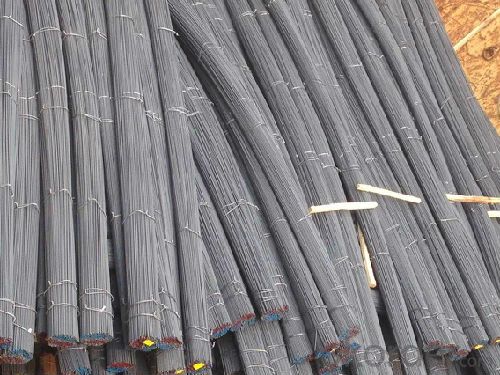
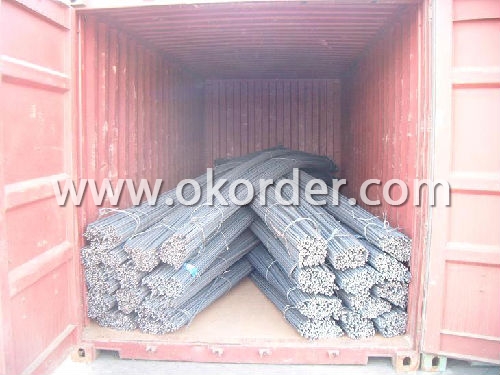
Deformed Steel Bar in factory
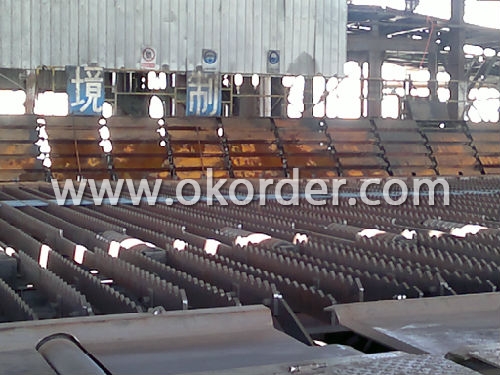
Note:
1. Our products are produced according to national standard (GB), if not, supply according to national standards (GB) or agreement as customer required.
2. Other Grade and Standard Deformed Steel Bar we can supply:
Grade: GR40/GR60, G460B/B500A/B500B/B500C,BST500S
Standard: ASTM, BS, DIN
The Minimum Order Quantity of these products is high, and need to be confirmed.
3. We can not only supply Deformed Steel Bar; if you need anything about building materials, please contact us for further information.
4. Please send us your detail specifications when inquire. We will reply to you as soon as possible. We sincerely hope we can establish a long stable business relationship.
- Q: What is the role of steel rebars in preventing shrinkage cracks in concrete?
- The prevention of shrinkage cracks in concrete is greatly aided by the use of steel rebars. These cracks occur naturally during the drying and curing process of concrete, as the water content evaporates and the material contracts. This contraction can weaken the concrete's structural integrity and durability. The addition of steel rebars to concrete helps counteract shrinkage cracks by providing tensile strength. Concrete is strong when compressed, but weak when subjected to tension. As the concrete shrinks during drying, the rebars act as reinforcement and resist the forces that develop. This prevents the formation and spread of shrinkage cracks. The rebars essentially form a framework within the concrete, evenly distributing the tensile stresses and preventing them from accumulating in one area. By controlling the shrinkage of the concrete, the rebars help maintain the overall stability and integrity of the structure. Moreover, steel rebars also increase the overall strength and load-bearing capacity of the concrete. The reinforcement makes the concrete more resistant to bending, shearing, and other forces that can result in cracking. Furthermore, the presence of rebars in the concrete also helps regulate the width and depth of any cracks that may still occur. By confining and limiting the size of cracks, the rebars prevent them from expanding and potentially compromising the concrete's structural integrity. In conclusion, steel rebars are essential in preventing shrinkage cracks in concrete. They provide tensile strength, distribute stresses, enhance overall strength, and control crack size. The inclusion of rebars ensures a more durable and reliable structure, reducing the risk of damage and prolonging the concrete's lifespan.
- Q: What's the difference between rebar and thread steel?
- A ribbed steel bar with 2 longitudinal ribs and uniformly distributed ribs along the length. This is thread steel. It belongs to the category of reinforcement.
- Q: What is the difference between carbon steel and stainless steel rebars?
- Carbon steel and stainless steel rebars are both types of steel reinforcement used in construction, but they have distinct differences in composition and properties. Carbon steel rebars are made from a combination of iron and carbon, with small amounts of other elements such as manganese and copper. The carbon content in these rebars typically ranges from 0.15% to 0.60%. Carbon steel rebars are strong, durable, and cost-effective. They have good tensile strength, which is crucial for reinforcing concrete structures. However, they are susceptible to corrosion if not properly protected, especially in environments with high moisture or exposure to chemicals. On the other hand, stainless steel rebars are made from a combination of iron, chromium, nickel, and other alloying elements. The chromium content in stainless steel is typically above 10.5%, which creates a protective layer of chromium oxide on the surface of the rebar, preventing corrosion. Stainless steel rebars have excellent corrosion resistance, even in harsh environments with high humidity, saltwater, or exposure to chemicals. They are also highly durable and have high tensile strength, similar to carbon steel rebars. The main difference between carbon steel and stainless steel rebars is their corrosion resistance. Carbon steel rebars require proper protective coatings, such as epoxy or galvanization, to prevent corrosion. On the other hand, stainless steel rebars have inherent corrosion resistance due to the presence of chromium oxide layer, eliminating the need for additional coatings. Another difference is the cost. Carbon steel rebars are generally cheaper compared to stainless steel rebars. However, the total cost of a project should also consider the long-term maintenance costs associated with corrosion protection measures required for carbon steel rebars. In summary, carbon steel rebars are strong and cost-effective but require additional corrosion protection measures, while stainless steel rebars have excellent corrosion resistance and durability but come at a higher cost. The choice between the two depends on the specific project requirements, budget, and expected environmental conditions.
- Q: Can steel rebars be used in nuclear power plant construction?
- Yes, steel rebars can be used in nuclear power plant construction. Steel rebars are commonly used in reinforced concrete structures, including those found in nuclear power plants, to provide structural strength and durability. These rebars help reinforce the concrete and enhance the overall integrity and safety of the construction.
- Q: Are steel rebars suitable for use in structures with aggressive soil conditions?
- Yes, steel rebars are suitable for use in structures with aggressive soil conditions. Steel rebars have excellent strength and durability, making them resistant to the corrosive effects of aggressive soil. Additionally, rebars can be coated with protective materials or used in conjunction with other corrosion-resistant techniques to enhance their performance in such conditions.
- Q: What is the process of anchoring steel rebars in masonry walls?
- To ensure a secure and reliable connection between the steel reinforcement and the masonry structure, several steps are involved in anchoring steel rebars in masonry walls. Firstly, a detailed design and plan for the reinforcement layout in the masonry wall must be established. This involves determining the spacing, size, and placement of the rebars based on structural requirements. Next, the masonry wall needs to be prepared by cleaning the surface and removing any loose debris or obstructions. This creates a clean and stable base for the rebars. Then, holes are drilled into the masonry wall at predetermined locations according to the reinforcement design. These holes are slightly larger than the diameter of the rebars to allow for easy insertion. After drilling, the holes are cleaned to remove any dust or debris. A bonding agent, such as epoxy or cementitious grout, is then applied to the holes. This enhances the bond between the rebars and the masonry wall. The steel rebars are then inserted into the prepared holes, ensuring alignment according to the reinforcement design. They are pushed into the holes until they reach the desired depth, fully embedding them in the bonding agent. Once the rebars are in place, the bonding agent needs time to cure and harden. The curing time varies depending on the type of bonding agent used and the environmental conditions. It is crucial to follow the recommended curing time to ensure secure anchoring. After the curing process is complete, a thorough inspection is conducted to ensure the rebars are properly anchored and meet the required specifications. This involves checking for proper alignment, depth, and overall stability. By following these steps, the process of anchoring steel rebars in masonry walls provides structural reinforcement and strength to the overall masonry structure. This enhances durability and resistance to various forces and loads.
- Q: What are the different methods of fixing steel rebars in formwork?
- There are several methods of fixing steel rebars in formwork, including tying the rebars using wire or metal ties, using rebar spacers or chairs to hold the rebars in place, using rebar couplers to join rebars together, and using mechanical or adhesive anchors to secure the rebars to the formwork.
- Q: What is the effect of moisture on steel rebars?
- The effect of moisture on steel rebars can be significant and can lead to various issues. Moisture can accelerate the corrosion process of steel rebars, causing them to rust and deteriorate over time. This corrosion weakens the structural integrity of the rebars and can lead to structural failures in concrete structures. When steel rebars are exposed to moisture, the water reacts with the iron in the steel, causing an electrochemical reaction known as corrosion. This reaction produces iron oxide or rust, which expands and causes the rebars to crack and spall. As the corrosion progresses, the rebars lose their strength, which can compromise the overall stability of the structure. Moisture can also contribute to the formation of carbonation in concrete, which further increases the risk of corrosion for steel rebars. Carbonation occurs when carbon dioxide from the atmosphere reacts with the calcium hydroxide in concrete, reducing the alkalinity of the concrete. This reduction in alkalinity lowers the passivation of the rebars, making them more susceptible to corrosion. In addition to corrosion, moisture can also lead to other problems such as concrete expansion, freeze-thaw damage, and efflorescence. When moisture enters the concrete and freezes, it expands, causing cracking and spalling. This freeze-thaw cycle can further accelerate the corrosion process of steel rebars. Efflorescence, on the other hand, is the crystalline deposit that forms on the surface of concrete when moisture evaporates and leaves behind salts. This white, powdery substance can degrade the appearance of concrete structures and indicate potential moisture-related issues. To mitigate the effects of moisture on steel rebars, various preventive measures can be taken. These include using corrosion-resistant rebars, applying protective coatings or membranes to the rebars, ensuring proper concrete cover over the rebars, and implementing proper drainage systems to prevent the accumulation of moisture. Regular inspections and maintenance are also crucial to identify and address any moisture-related issues before they escalate and cause structural problems.
- Q: What is the maximum allowable diameter for steel rebars?
- The maximum allowable diameter for steel rebars varies depending on the specific building codes and standards being followed. However, in general, the maximum allowable diameter for steel rebars typically ranges from 40mm to 50mm.
- Q: Can steel rebars be used in the construction of shopping centers?
- Indeed, steel rebars possess the capability to be utilized in the construction of shopping centers. These rebars, known as reinforcing bars, are extensively employed in the construction sector to fortify concrete structures. Shopping centers typically necessitate robust, resilient, and enduring infrastructure, and steel rebars furnish the indispensable strength and reinforcement essential for supporting the building's weight and load. They effectively thwart cracks, augment structural stability, and heighten the overall durability of the construction. Furthermore, steel rebars can be effortlessly molded and trimmed to conform to the specific design prerequisites of a shopping center, rendering them an adaptable and pragmatic choice for construction projects.
Send your message to us
High Quality GB Standard Deformed Steel Rebar HRB400
- Loading Port:
- China main port
- Payment Terms:
- TT or LC
- Min Order Qty:
- 50 m.t.
- Supply Capability:
- 100000 m.t./month
OKorder Service Pledge
OKorder Financial Service
Similar products
Hot products
Hot Searches
Related keywords
